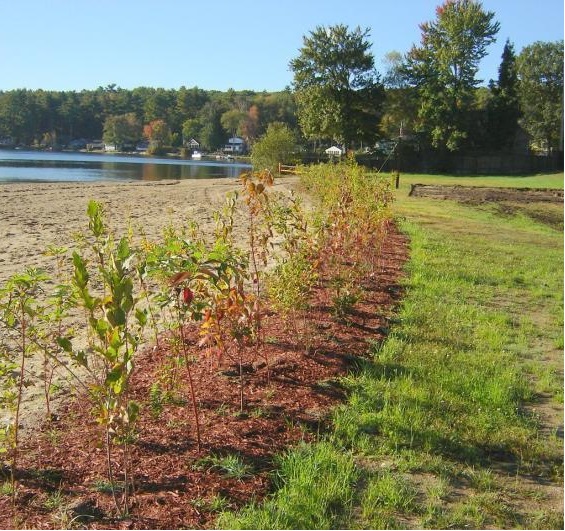Tree and Shrub Planting

Definition
Stabilizing disturbed areas by establishing a vegetative cover of trees or shrubs.
Purpose
- To stabilize the soil with vegetation other than grasses or legumes.
- To provide food and shelter for wildlife.
- To provide windbreaks or screens.
Where Practice Applies
Trees and shrubs may be used:
- On steep or rocky slopes,
- Where mowing is not feasible,
- As ornamentals for landscaping purposes, or
- In shaded areas where grass establishment is difficult.
Advantages
- Trees and shrubs can provide superior, low-maintenance, long-term erosion protection. They may be particularly useful where site aesthetics are important.
- Besides their erosion and sediment control values, trees and shrubs also provide natural beauty and wildlife benefits.
Disadvantages/Problems
- Except for quick-growing species; it may take a number of years for trees to reach full size.
- Trees and shrubs may be expensive to purchase and establish. They may also be more subject to theft than materials used in other practices.
Planning Considerations
- There are many different species of plants from which to choose, but care must be taken in their selection. It is essential to select planting material suited to both the intended use and specific site characteristics.
- None of these plants, however, is capable of providing the rapid cover possible by using grass and legumes. Vegetative plans must include close-growing plants or an adequate mulch with all plantings.
- When used for natural beauty and wildlife benefits, trees and shrubs are usually more effective when planted in clumps or blocks.
Species Selection
- When erosion or sediment control is not of primary, immediate concern; areas may be stabilized using rugged, fast-growing trees and shrubs that once established have a good record of taking care of themselves. These plants may not be the best ornamentals, but establishment can usually be made with these low-maintenance trees and shrubs.
- In some cases, it may be desirable to use trees and shrubs as screening plants to shield sites such as gravel pits from public view. These plants should be given the best possible attention at planting time, with good soil water, and mulching.
- Contact your local Extension Services for recommendations on shrub and tree species for various soil conditions
Planting
-
Trees and shrubs will do best in topsoil. If no topsoil is available, they can be established in subsoil with proper amendment. If trees and shrubs are to be planted in subsoil, particular attention should be paid to amending the soil with generous amounts of organic matter. Mulches should also be used.
-
Good quality planting stock should be used. For mass plantings, one or two- year old deciduous seedlings and 3 or 4-year old coniferous transplants should be used. For smaller planting groups or individuals specimen plants, bare rooted, container grown or balled and burlaped stock may be preferred because of their larger size. Stock should be kept cool and moist from time of receipt until planted.
-
Competing vegetation, if significant, should be destroyed or suppressed prior to planting by scalping a small area where the plant is to be placed.
-
Stock should be planted in the spring by May 15. No fertilizer should be used at the time of planting unless it is a slow-release type formulated for trees and shrubs. Plants should be planted at the approximate depth they were growing in the nursery; the roots should be uncrowded; the soil should be firmly packed against the roots after setting.
-
Shrubs should be mulched to a depth of 4 inches or more with woodchips, bark, peat moss or crushed stone. Mulch to the edge of the planting at, but not less than, one foot from the trunk.
Maintenance
- Deciduous plants should be fertilized six months to one year after planting with 1⁄4 pound of a 10-6-8 fertilizer per plant (or 25 lbs. per 1,000 sq. ft. for block plantings) or the equivalent. A slow release fertilizer is preferred. Evergreens should be fertilized half as much.
- The planting should be inspected after the first and second growing seasons. Replanting and repairs, as needed to provide adequate cover, should be scheduled. Fertilizer should be applied to shrubs every 3 to 5 years after planting.